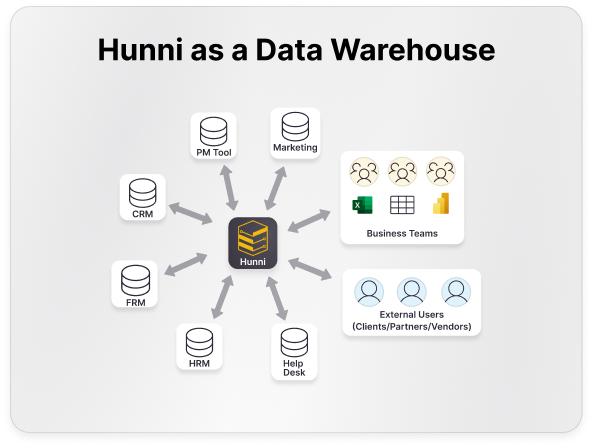A tech stack refers to the collection of software, tools, and systems an organization uses to manage its data and operations. Every company has a different tech stack, depending on its size, industry, and technical maturity. More mature companies with dedicated technical resources often employ a hub-and-spoke model to efficiently manage and distribute data within their stack.
The Hub-and-Spoke Model
At the center of the hub-and-spoke model is typically a data warehouse, which acts as the central repository for collecting, storing, and distributing data across various systems. This architecture ensures that data flows smoothly between different applications while maintaining consistency, security, and accessibility. The benefits of this model include:
- Centralized data management for better governance and oversight.
- Integration between core business applications (ERPs, CRMs, etc.).
- Improved data accuracy by reducing redundancy and inconsistencies.
- Easier scalability to accommodate growing business needs.
Working alongside a data warehouse, Hunni serves as a data distribution hub, securely providing internal and external users with controlled access to data. It also streamlines the ingestion of new data, which can then be leveraged across an organization’s data fabric.

Hunni as a Data Warehouse
For organizations that lack a traditional data warehouse or a formal data strategy, Hunni can act as a centralized data repository to store, organize, and distribute business-critical information. Instead of struggling with scattered spreadsheets and siloed data, Hunni provides:
- A structured environment for data storage and management.
- An easy-to-use interface for configuring datasets without technical expertise.
- Secure and permission-based access to ensure data governance.
By serving as a lightweight data warehouse, Hunni helps organizations of all sizes manage and leverage their data more effectively, ensuring that key stakeholders can access the information they need without the complexity of traditional data warehousing solutions.

Bridging the Gap for Non-Technical Users
Regardless of a company’s tech maturity, non-technical users across the organization benefit from accessing data that exists across the stack. However, these users don’t necessarily need direct access to each system, nor do they always have the technical expertise to navigate complex software.
For example, an implementation team member might not need full access to the CRM, but would greatly benefit from seeing the current pipeline of prospects to better plan upcoming implementations. Without a structured way to share data, employees often resort to workarounds like exporting reports, which can lead to inefficiencies and security risks.
Enter Hunni: A Simplified Data Sharing Solution
Even if an organization has a mature tech stack and a centralized data warehouse, it still needs a simple platform to securely disseminate data across the organization. That’s where Hunni comes in.
With the Hunni API, you can integrate data from a data warehouse or directly from vendors within the stack, and then permission data access to the right individuals through a user-friendly platform that anyone can understand. Key benefits include:
- No technical expertise required – Users can access shared data without needing direct access to core systems.
- Secure data distribution – Ensure employees get the data they need without compromising security.
- Improved operational efficiency – Reduce reliance on manual exports and risky sharing practices.
Empowering Non-Technical Users to Configure Structured Data
Hunni is not just a data-sharing platform, it also enables non-technical users to easily create and configure structured data tables. These tables become an integral part of an organization’s data fabric, making them accessible and reusable across the company. Instead of relying on scattered Excel files hidden in folders with little oversight, Hunni provides a simple interface for non-technical users to create and manage their own datasets.
By empowering non-technical users to configure structured datasets, Hunni ensures that data is not only shared effectively, it also encourages new datasets to be captured, more easily leveraged across the organization, and securely governed.
Hunni as the Gatekeeper for External Data Sharing
Beyond internal data distribution, organizations must also securely share data with clients, partners, and vendors. Many companies, both large and small, still rely on emailing Excel files, which is not only inefficient but also a significant security risk.
Hunni serves as a secure and efficient alternative by allowing organizations to permission and share structured data externally without the risks associated with email attachments. This means:
- Controlled access – Ensure only the right people have access to specific data sets.
- Live, dynamic data – Avoid outdated reports by providing real-time access.
- Compliance and audit tracking – Keep a record of who accessed and shared data for improved governance.
Conclusion
Hunni is a powerful addition to any tech stack, providing a streamlined, secure, and user-friendly platform for internal and external data sharing. Whether your organization has a mature hub-and-spoke architecture or is still evolving its data strategy, Hunni ensures that everyone, from non-technical employees to external partners, gets access to the right data, at the right time, in the most secure and efficient way possible.
Ready to enhance your tech stack with Hunni?

